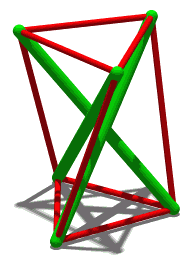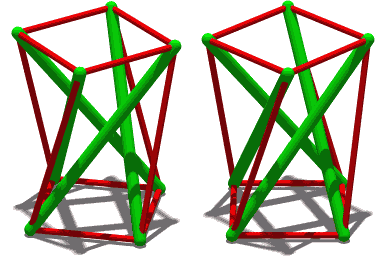
Back التضاغط Arabic Тенсегрити Bulgarian Tensegritat Catalan Tensegrita Czech Tensegrity (Architektur) German Tensegridad Spanish سیستمهای کشبستی Persian Tenségrité French Tensegrità Italian テンセグリティ Japanese

| Stereo image | |||
|---|---|---|---|
| |||
| |||
| |||
| |||
| Animation A similar structure but with four compression members. | |||
Tensegrity, tensional integrity or floating compression is a structural principle based on a system of isolated components under compression inside a network of continuous tension, and arranged in such a way that the compressed members (usually bars or struts) do not touch each other while the prestressed tensioned members (usually cables or tendons) delineate the system spatially.[1]
Tensegrity structures are found in both nature as well as human-made objects: in the human body, the bones are held in compression while the connective tissues are held in tension, and the same principles have been applied to furniture and architectural design and beyond.
The term was coined by Buckminster Fuller in the 1960s as a portmanteau of "tensional integrity".[2]
- ^ Gómez-Jáuregui 2010, p. 19.
- ^ Swanson, RL (2013). "Biotensegrity: a unifying theory of biological architecture with applications to osteopathic practice, education, and research-a review and analysis". The Journal of the American Osteopathic Association. 113 (1): 34–52. doi:10.7556/jaoa.2013.113.1.34. PMID 23329804.
© MMXXIII Rich X Search. We shall prevail. All rights reserved. Rich X Search
